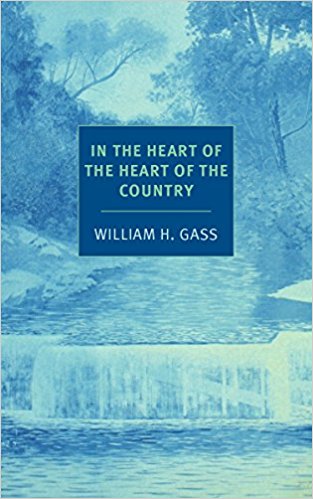
('Profile' © Pekka Nikrus, 2016)
BY THE MOUTH AND FOR THE EAR:
William H. Gass’s In the Heart of the Heart of the Country
by NICOLE MANSOUR
The sound of the belch’d words of my voice loos’d to the eddies of the wind
~ Walt Whitman, ‘Song of Myself’
When we think of sound and rhythm in literature, we most often think of poetry. For it is the waves of sound and rhythm we ride upon most explicitly in that form; that vibrant pulse reverberating as we recite each line, be it from Shakespeare’s sonnets, Emily Dickinson’s incandescent ‘envelope poems’ or Walt Whitman’s Leaves of Grass. Together, sound and rhythm create the symphony of poetic language. As Stéphane Mallarmé once wrote regarding certain figurations of language: ‘It is the same as an orchestra, only literary and silent.’ In truth, this musical heartbeat underpins much notable creative prose. And perhaps one of the finest modern examples of it can be found in American writer William Gass’s seminal collection of short stories, In the Heart of the Heart of the Country.
 First published in 1968, and comprising one novella and three short stories, Gass’s composition – a convergence of the murkier lulls of life – reveals his dazzling linguistic energy and a remarkable gift for evoking the aural quality of the word. His prose depicts small town life: the rural in twilight and shadow; the subtle shifts between despair and devastation; a thoughtfully precise recognition of loneliness.
First published in 1968, and comprising one novella and three short stories, Gass’s composition – a convergence of the murkier lulls of life – reveals his dazzling linguistic energy and a remarkable gift for evoking the aural quality of the word. His prose depicts small town life: the rural in twilight and shadow; the subtle shifts between despair and devastation; a thoughtfully precise recognition of loneliness.
In the opening story, ‘The Pedersen Kid’ – the only tale in the collection where plot, rather than image, takes precedent – a farmer, his son, and his hired help drive through a cruel winter snow to tell their neighbour that his son has been found almost frozen to death. Narrated in a Faulkner-like voice by the farmer’s young boy, Jorge, Gass captures both his character’s confusion and experiences, as well as the physical intensity of the natural environment:
Who knows, I thought, the way its been snowing, we mightn’t have found him till spring. Even if he was dead in our kitchen, I was glad Big Hans had found him. I could see myself coming out of the house some morning with the sun high up and strong and the eaves dripping, the snow speckled with drops and the ice on the creek slushing up; coming out and walking down by the crib on the crusts of the drift […] coming out to play my game with the drifts […] and I could see myself losing, breaking through the big drift that was always sleeping up against the crib and running a foot right into him, right into the Pedersen kid curled up, getting soft.
Gass’s tightly wound blaze of language is so compelling it seems impossible to believe that this story remained unpublished until almost eight years after it was written: it first appeared in John Gardner’s literary journal, MSS, in 1961. That said, the ‘management of monosyllables, the alternation of short and long sentences, the emotional integrity of the paragraph’ and the ‘elevation of the most ordinary diction into some semblance of poetry’ – points Gass notes in his preface to the New York Review of Books re-issue of 2015 – do have the effect of giving the narrative’s central action a particularly nebulous and poetic urgency.
Throughout the stories that follow, Gass takes a gathering of Midwest farmers, housewives, hillbillies and itinerant preachers and turns them into tragedy. In ‘Mrs Mean’, a voyeur observes and elucidates on the lives of his neighbours from the boundary of his porch, only to discover that one nameless woman who lives across the road – her overbearing domesticity and ostensible meanness toward her husband and children a constant beguilement – actually eludes him. And in ‘Icicles’, a real estate agent becomes absorbed by the humdrum of small town life during a long winter.
Conflict swarms too in ‘Order of Insects’, in which a housewife, initially disturbed and disgusted each morning by the large black bugs she finds dead in her house, soon becomes fascinated, as she discovers a dark beauty in their ugliness:
But this bug that I hold in my hand and know to be dead is beautiful, and there is a fierce joy in its composition that beggars every other, for its joy is the joy of stone, and it lives in its tomb like a lion.
It is a fierce joy indeed that Gass exudes in this piece: the woman’s hysteria pitched perfectly, his prose truly ingenious.
Yet his masterpiece in this collection is undoubtedly the title story, in which a middle-aged poet roams his eye across the Midwestern landscape, psyche wandering between desolation and promise. Gass’s language has the pressure of the weather – a shivering sky, or the distortion of clouds, all of it gently rolling over the mystery of human consciousness:
There’s a row of headless maples behind my house, cut to free the passage of electric wires. High stumps, ten feet tall, remain, and I climb these like a boy to watch the country sail away from me. They are ordinary fields, a little more uneven than they should be, since in the spring they puddle. The topsoil’s thin, but only moderately stony. Corn is grown one year, soybeans another. At dusk starlings darken the single tree – a larch – which stands in the middle. When the sky moves, fields move under it. I feel, on my perch, that I’ve lost my years. It’s as though I were living at last in my eyes, as I have always dreamed of doing, and I think then I know why I’ve come here: to see, and so to go out against new things – oh god how easily – like air in a breeze. It’s true there are moments – foolish moments, like ecstasy on a tree stump – when I’m all but gone, scattered I like to think like seed, for I’m the sort now in the fool’s position of having love left over which I’d like to lose; what good is it to me now, candy ungiven after Halloween?
 Gass boldly captures the devastating rhythms of both landscape and spirit: the vast, unsympathetic topography perpetually in contrast with the furtive human mind. Exterior is constantly in flux with interior; both obscure the peripheries, but inevitably reveal the heartland. Words are consumed in all their infinite possibility: transfigured, aesthetically shaped, and unexpectedly sounded. In a 1977 Paris Review interview, Gass emphatically states: ‘by the mouth for the ear: that’s the way I’d like to write.’ Certainly, it is a comment that seems to directly allude to the aural quality of his language, its pitch and echo as it is expelled off the tongue and impaled in space.
Gass boldly captures the devastating rhythms of both landscape and spirit: the vast, unsympathetic topography perpetually in contrast with the furtive human mind. Exterior is constantly in flux with interior; both obscure the peripheries, but inevitably reveal the heartland. Words are consumed in all their infinite possibility: transfigured, aesthetically shaped, and unexpectedly sounded. In a 1977 Paris Review interview, Gass emphatically states: ‘by the mouth for the ear: that’s the way I’d like to write.’ Certainly, it is a comment that seems to directly allude to the aural quality of his language, its pitch and echo as it is expelled off the tongue and impaled in space.
In his essay ‘The Hatred of Poetry’, Ben Lerner recalls a childhood linguistic discovery:
I remember speaking a word whose meaning I didn’t know but about which I had some inkling, some intuition, then inserting that word into a sentence, testing how it seemed to fit or chafe against the context and syntax, rolling the word around, as it were, on my tongue.
For me, Gass’s use of language strangely exemplifies Lerner’s quest for meaning and resonance. Hearing Gass’s words roll around – in my mind and in my mouth – seems to unearth an even greater depth to their meaning. Even after I turned the final page of this collection, its score of words echoed: the distinctive alliteration and onomatopoeia; the oscillating lengths of the sentences; the anxious narratives and seductive repetition of unusual phonics resonated. Like Whitman’s ‘belch’d words’, his voice ‘loos’d to the eddies of the wind’, I could hear Gass’s prose, as if erupted into the air but, at the same time, was spoken aloud only to me. And with these vibrations came a more profound understanding of Gass’s stories: for they are startling, piercing, bold; they are intelligent and provocative and unexpected. Gass sings of a world where snow is ‘as blue as the sky’, stars are ‘flakes being born that will not fall’, and where ‘sparrows sit like fists’ on wire. In this collection, Gass has composed a symphony.
Emerson said that ‘wise men … fasten words again to visible things’. Yet Gass seems to fasten words even to the invisible, to the concealed and obscured fragments we bury, or abandon, throughout our lives. He captures all that so often goes unspoken, and gives it a sound; he picks up all that lingers in the quiet corners of our rooms and our consciousness, and hurls it back at us, until it strikes, deeply, piercing the heart. And whether bellowed in song or murmured in whispers, the sound of Gass’s words remain boundlessly resonant.
~

Originally from Sydney, Nicole Mansour has lived in Buenos Aires, Melbourne, Hong Kong and London. A graduate of Actors Centre Australia, she has a BA in Literature and is currently completing a MA in Creative Writing. Like Susan Sontag, she loves to read the way other people love to watch television.

